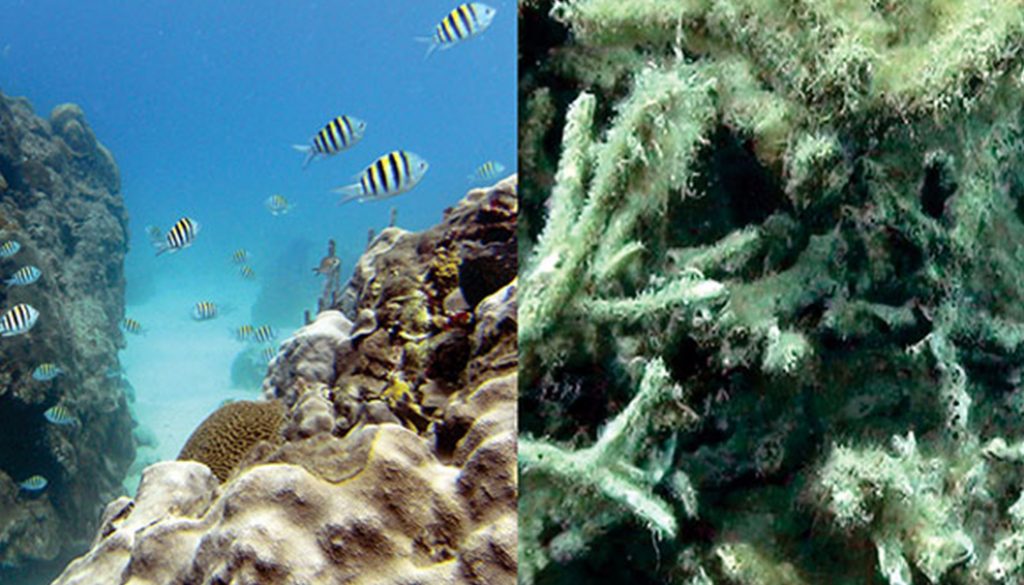Ignacio Winfield a, *, José M. Guerra-García b
a Laboratorio de Crustáceos, Facultad de Estudios Superiores Iztacala, Universidad Nacional Autónoma de México, Avenida de los Barrios 1, Los Reyes Iztacala, 54090 Tlalnepantla, Estado de México, Mexico
b Laboratorio de Biología Marina, Departamento de Zoología, Facultad de Biología, Universidad de Sevilla, Avenida Reina Mercedes 6, 41012 Sevilla, Spain
*Corresponding author: ignacioc@unam.mx (I. Winfield)
Received: 20 February 2020; accepted: 30 July 2020
http://zoobank.org/urn:lsid:zoobank.org:pub:950A3C97-1649-4506-87DC-BA46BE972320
Abstract
A new species of the genus Deutella Mayer, 1890 is described and illustrated, and a key to identify the Deutella species from the Gulf of Mexico is given. The specimens were collected from coral rubble at 18 m depth in Tuxpan-Lobos coral reef system, W Gulf of Mexico. Deutella pseudoincerta n. sp. is remarkably close to Deutella incerta (Mayer, 1903), but can be easily distinguished by: length and shape of pereopod 5 especially distal article; length and width of adult male gnathopod 2; shape and size of tubercles in male abdominal appendages. The new species increases the number of Deutella species to 14 worldwide, and 18 species of Caprellidae from the Gulf of Mexico.
Keywords: Crustacea; Malacostraca; Coral reef; Veracruz; Taxonomy
© 2021 Universidad Nacional Autónoma de México, Instituto de Biología. This is an open access article under the CC BY-NC-ND license
Una especie nueva de Deutella (Amphipoda: Caprellidae) del golfo de México
Resumen
Se describe una especie nueva del género Deutella Mayer, 1890 y se presenta una clave para identificar las especies del género Deutella del golfo de México. Los especímenes fueron recolectados de roca coralina a 18 m de profundidad en el sistema arrecifal Tuxpan-Lobos, oeste del golfo de México. Deutella pseudoincerta n. sp. es muy cercana a Deutella incerta (Mayer, 1903), pero se puede diferenciar por: longitud y forma de pereópodo 5, específicamente artejo distal; longitud y amplitud del gnatópodo 2 del macho adulto, y forma y tamaño de tubérculos en apéndices abdominales del macho. La especie nueva incrementa a 14 el número de especies de Deutella en el mundo y a 18 las de Caprellidae en el golfo de México.
Palabras clave: Crustacea; Malacostraca; Arrecife de coral; Veracruz; Taxonomía
© 2021 Universidad Nacional Autónoma de México, Instituto de Biología. Este es un artículo Open Access bajo la licencia CC BY-NC-ND
Introduction
The Caprellidae (skeleton shrimps) belong to the Order Amphipoda, and include benthic marine organisms associated with a wide variety of substrates where they feed, reproduce and protect themselves against different predators (Iwasa-Arai et al., 2019). In coral reef ecosystems the caprellids have been documented on several substrates, such as algae, sponges, seagrasses, hydroids, bryozoans, soft bottoms, and coral rubble (Paz-Ríos et al., 2014; Winfield & Ortiz, 2013).
The genus Deutella Mayer, 1890 is characterized by the following characters: flagellum of antenna 2 with 2 articles, swimming setae absent; mandibular palp 3-articulate, setal formula for distal article 1-x-1, 2-x-1 or 1 seta, molar present; outer lobe of maxilliped longer than inner lobe; pereopod 5, 6-articulate; male abdomen with a pair of appendages and another of setose lobes (Alarcón-Ortega & Carballo, 2019; Guerra-García, 2002a, 2003). So far, Deutella includes 13 nominal species of caprellid amphipods distributed worldwide, mainly in the northern hemisphere along the American coasts (both Atlantic and Pacific oceans) (Guerra-García, 2003). Before this study, 3 species of this genus, Deutella californica Mayer, 1890, Deutella incerta (Mayer, 1903) and Deutella mayeri Stebbing, 1895, had been recorded from the Gulf of Mexico (GoM) from litoral fringe to continental slope, associated with hard substrates, algal mats, seagrasses, and soft bottoms, as epibiotic component (Winfield & Ortiz, 2013).
During a short stay of the first author (IW) at the University of Sevilla, Spain, in 2019, several specimens of caprellids were studied at the Laboratory of Marine Biology. These organisms were obtained as part of a general research project focused on re-cording the biodiversity of the amphipod crustaceans inhabiting the coral reefs along the Veracruz continental shelf, GoM. Amongst these organisms, specimens of the genus Deutella from the Tuxpan/Lobos reef associated with coral rubble of Acropora cervicornis (Lamarck, 1816) were recognized and examined, and turned out to belong to an undescribed species of Deutella. In the present study we describe this new species and update the caprellid amphipod checklist from the GoM.
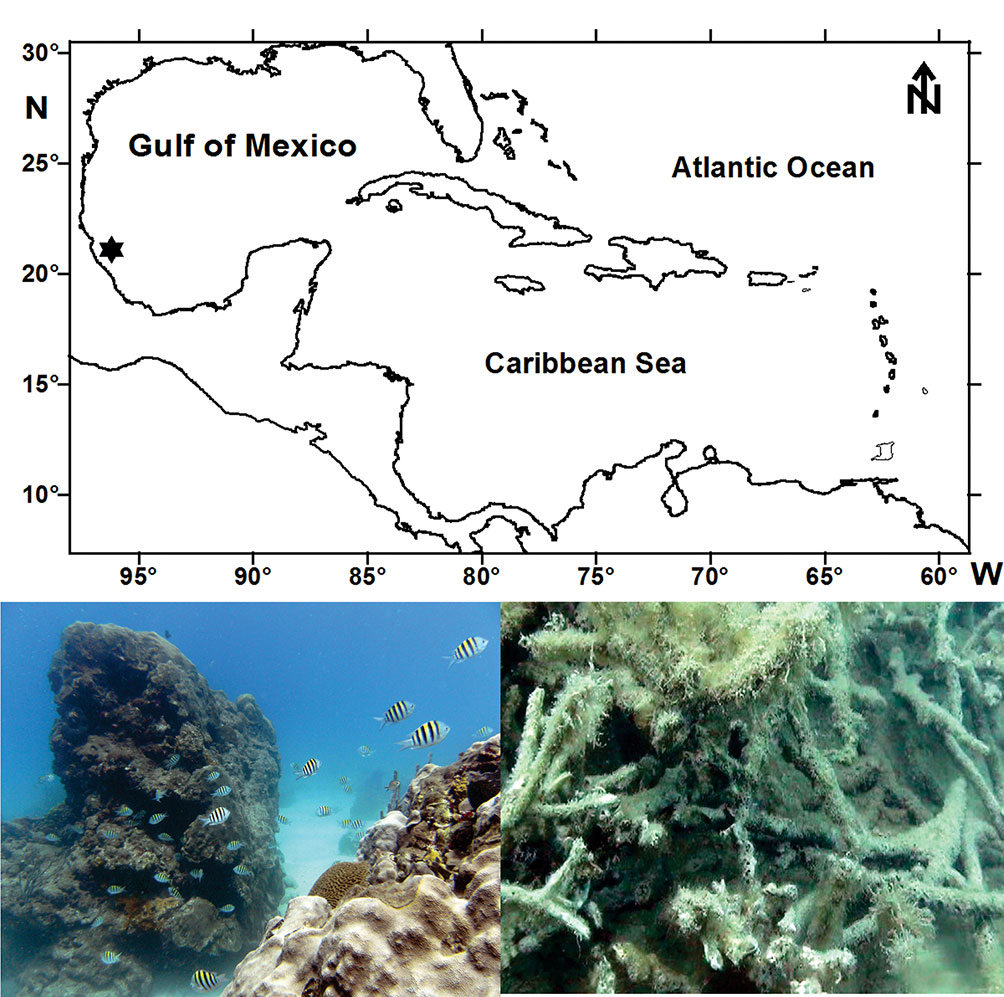
Materials and methods
The Tuxpan/Lobos coral reef system is located on the continental shelf off Veracruz State, Mexico, W GoM, at 21°00’55”-21°33’08” N, 97°10’30”-97°18’00” W (Fig. 1). It includes 6 emergent platform reefs grouped into 2 zones: Lobos zone, with the Blanquilla, Medio and Lobos reefs; and Tuxpan zone, with the Tanhuijo, Enmedio and Tuxpan reefs, with a maximum depth of 25 m (Chávez & Hidalgo, 1988). Samples of coral rubble were collected manually using SCUBA diving at 18 m depth. Aboard the vessel, 5.0 ml of an alcohol/formalin (1:1) solution was added to make the crustaceans leave the coral surface, and then the specimens were sieved through a 0.4 mm mesh and conserved in 70% ethanol.
Specimens of Deutella were examined, dissected and illustrated using a dissection microscope Leica M205C and a compound microscope Leica DM1000, both with a camera lucida, at Laboratory of Marine Biology, University of Sevilla, Spain. The names used for the structures, setae/spines, descriptions, remarks, and morphological comparisons were based on Guerra-García (2003). The classification system of Lowry and Myers (2013) was adopted in this study. The type material of the caprellid amphipods is deposited in the Museo Nacional de Ciencias Naturales, Madrid, Spain (MNCN).
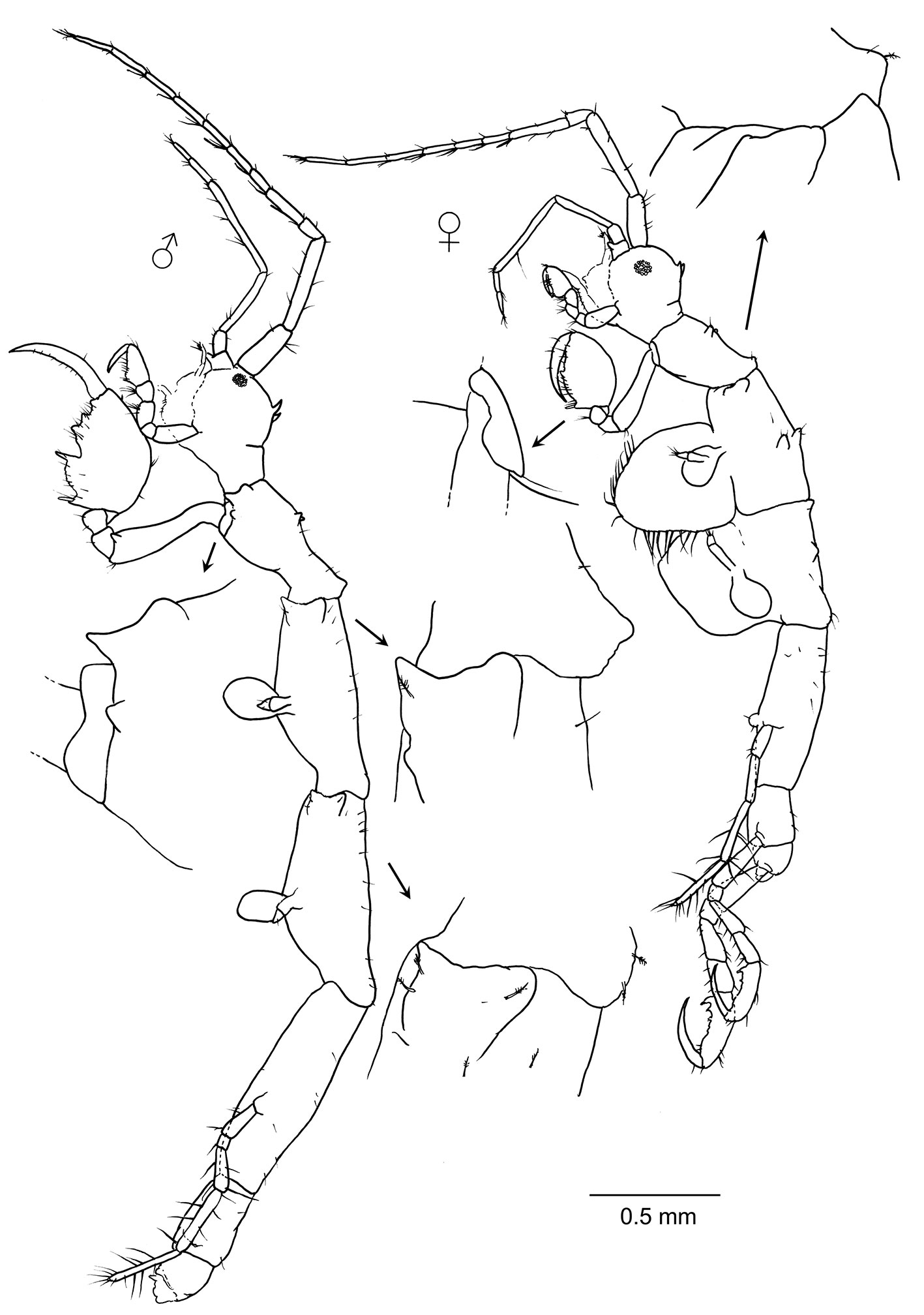
Description
Order Amphipoda Latreille, 1816
Suborder Senticaudata Lowry & Myers 2013
Superfamily Caprelloidea Leach 1814
Family Caprellidae Leach 1814
Subfamily Caprellinae Leach 1814
Deutella Mayer, 1890
Diagnosis. After Guerra-García (2002a, 2003) and Alarcón-Ortega and Carballo (2019), amended. Antenna 2 flagellum 2-articulate, swimming setae absent. Mandibular palp 3-articulate; setal formula for distal article 1-×-1, 2-×-1 or 1 seta; molar present, well developed. Outer plate of maxilliped longer than inner lobe. Pereopod 5 with 6 articles. Male abdomen with a pair of appendages and a pair of setose lobes.
Type species: Deutella californica Mayer, 1890.
Deutella pseudoincerta n. sp. Winfield & Guerra-García
(Figs. 2-6)
http://zoobank.org/urn:lsid:zoobank.org:author:E9D685
D8-1153-40B1-8F99-2940E0C97F50

Diagnosis. Eyes present. Head with 2 acute projections dorsally. Pereonites with dorsal fine setulae. Pereonite 2 with 2 medial rounded projections dorsally and 1 posterodorsal hump dorsally. Pereonites 3 and 4 dorsally smooth in male, and with 2 medial rounded projections and a distal hump in female. Pereonites 2, 3 and 4 with anterolateral projections in males; in females only pereonite 3 with anterolateral projections. Setal formula of distal article of mandibular palp 1-4-1, molar flake present. Outer lobe of maxilla 1 with 6 distal spines. Pereopods 3 and 4, 2-articulate, basal article of pereopod 4 elongate in female (2 × than male). Pereopod 5, 6-articulate, distal article extremely reduced to a nipple. Penes large. Male abdomen with a pair of appendages distally ornamented with tiny tubercles.
Description. Based on holotype male, 3.6 mm (MNCN 20.04/12014) and paratype female, 2.8 mm (MNCN 20.04/12015).
Lateral view (Fig. 2). Eyes present. Head with 2 acute dorsal projections. Suture between head and pereonite 1 present. Pereonites with tiny setulae. Pereonite 2 with 2 medial rounded projections and 1 distal hump dorsally; anterolateral projection near the coxa and a small one in the middle of the coxa (Fig. 2). Pereonites 3 and 4, dorsally smooth, with anterolateral projections (Fig. 2); pereonite 5 the longest; pereonite 7 the shortest. Gills suboval, length about 1.5 × width (Fig. 2).
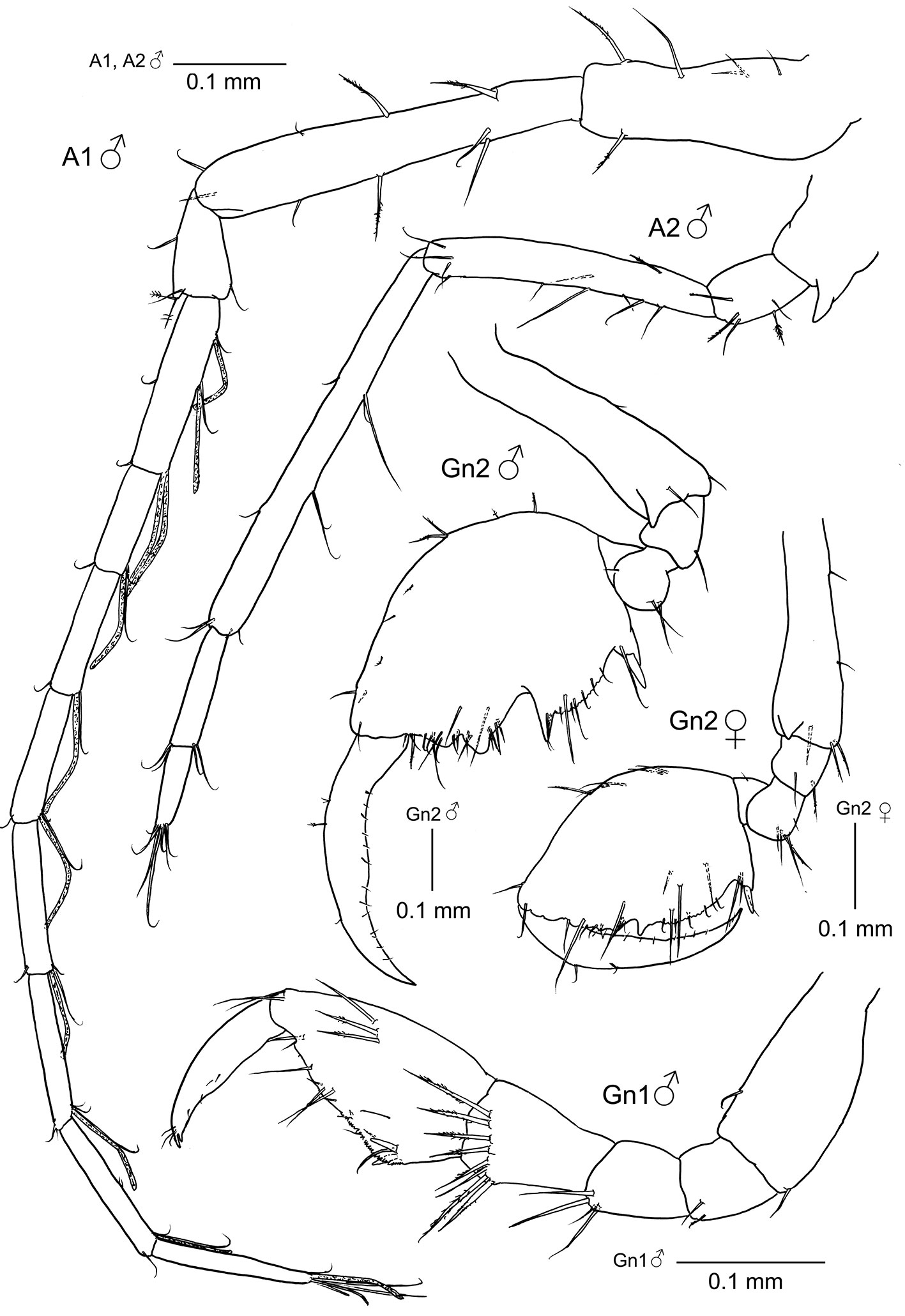
Mouthparts described from the male holotype except for the maxilliped which was broken in male and it is described from the female paratype (Fig. 3). Upper lip symmetrically bilobed, with tiny setulae apically. Mandibles 3-articulate palp; distal article of palp with a setal formula 1-4-1; mandibular molar robust; left mandible with incisor and lacinia mobilis 5-toothed, 3 rakers; incisor of right mandible 5-toothed, followed by a plumose plate and 2 rakers. Lower lip broken, no evidence of setulae. Maxilla 1 outer lobe with 6 serrate spines; distal article of palp with 4 robust setae and 1 slender seta medially. Maxilla 2 inner and outer lobe with 5 setae distally. Maxilliped inner plate with 3 plumose setae; outer plate about 2.5 × larger than inner plate, with 3 setae; palp 4-articulate, penultimate article of palp without distal projection, dactylus longer than article 3, with 2 rows of setulae.
Antennae (Figs. 2-4). Antenna 1 slightly longer than half of body length; flagellum 8-articulate. Antenna 2 with short setae (no swimming setae); basal article of peduncle with a distal projection; flagellum 2-articulate.
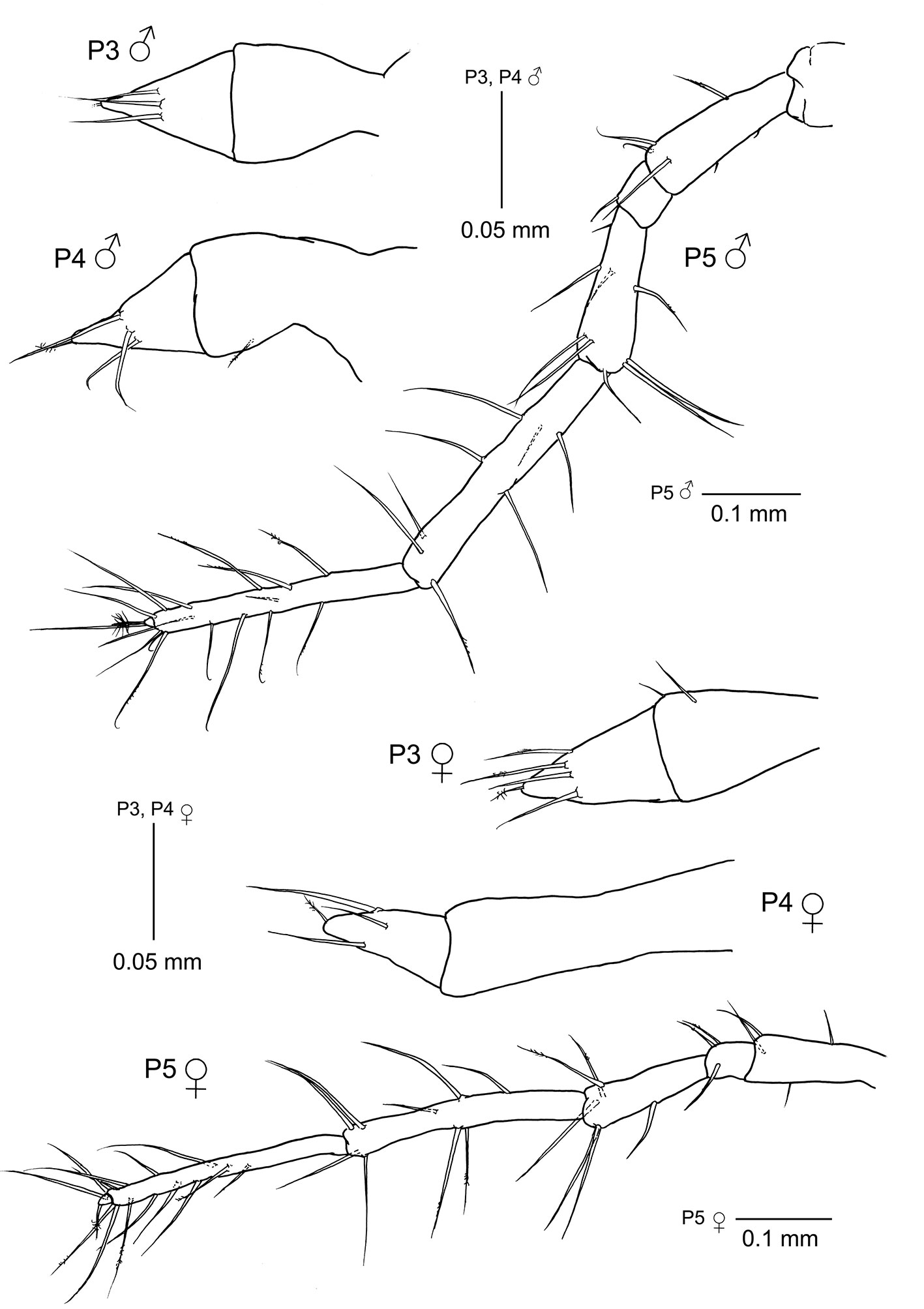
Gnathopods (Figs. 2-4). Gnathopod 1 basis shorter than ischium, merus and carpus combined; propodus length about 1.5 × width, triangular, palm with 2 proximal grasping spines and denticulate margin; dactylus bifid distally. Gnathopod 2 inserted on anterior half of pereonite 2; basis as long as pereonite 2 with a distal projection; ischium rectangular; merus rounded; carpus short and triangular; propodus oval, as long as basis; palm with a proximal projection on palmar corner carrying 1 grasping spine, U-shaped notch, and 2 more triangular projections distally; dactylus long, with a few setulae on ventral margin.
Pereopods (Figs. 2, 5, 6). Pereopods 3 and 4 subequal, 2-articulate, length about half of gills; basal article rectangular; distal article triangular, shorter than basal one, with 3 setae. Pereopod 5 weak and elongate, setose, 6-articulate; distal article extremely reduced to a tiny nipple, provided with a seta plumose distally. Pereopod 6 and 7 missing in holotype (described from female paratype) similar in feature but increasing in size respectively, 6-articulate; pereopod 6 propodus palm with a proximal projection with 2 acute grasping spines, followed by decreasing smaller projections provided with single spine; pereopod 7 propodus palm with a proximal projection with a single spine followed by decreasing smaller projections with single spine.
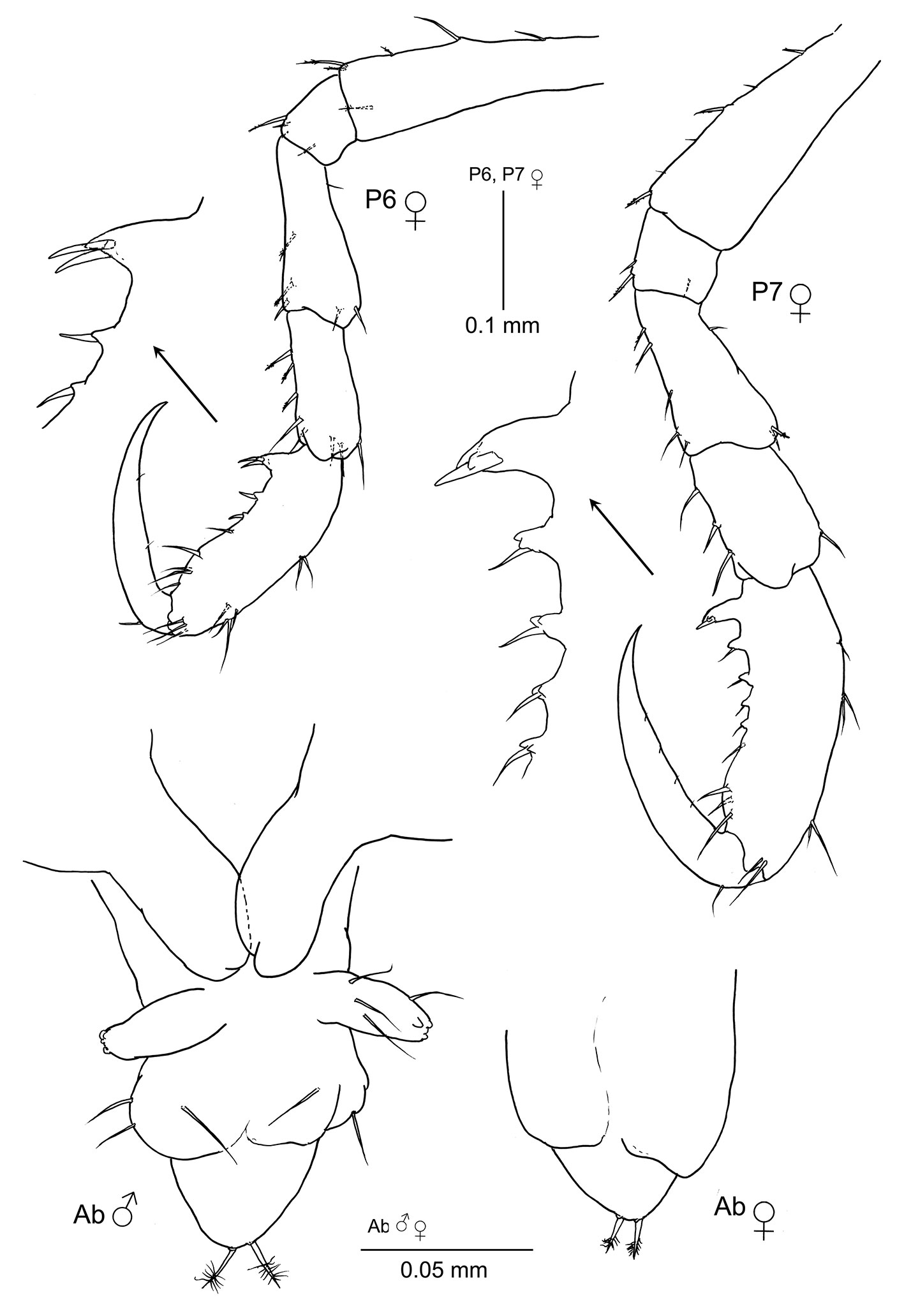
Penes exceptionally large, elongated situated laterally, with a suture medially on distal end (Fig. 6).
Abdomen with a pair of one-articulate appendages ornamented with distal tiny tubercles, a pair of lateral lobes with 2 or 3 setae and a single dorsal lobe with 2 apical plumose setae (Fig. 6).
Paratype female (MNCN 20.04/12015). Head with 2 acute dorsal projections. Pereonites 2, 3 and 4 with 2 medial rounded projections and 1 distal hump dorsally: anterolateral projection near coxa absent (Fig. 2). Pereonites 3 with anterolateral projection, pereonites 2 and 4 lacking anterolateral projections (Fig. 2). Flagellum of antenna 1 with 7 articles (Figs. 2, 4). Propodus of gnathopod 2 like male but medial projection and U-shaped notch less conspicuous than in male (Fig. 4). Oostegites on pereonite 3 setose, on pereonite 4 scarcely setose (Fig. 2). Pereonites 3-5 like those in male holotype apart from the proximal article of pereonite 4 which is more elongate in female. Abdomen without appendages (Fig. 6); lateral lobes without setae.
Taxonomic summary
Type material. Holotype adult male (used for drawings), 3.6 mm total length (MNCN 20.04/12014) (vial +2 slides), collected from the type locality, June 18, 2014, coll. I. Winfield. Paratype: 1 female (used for drawings), 2.8 mm total length (MNCN 20.04/12015) (vial +1 slide), collected from the type locality, June 18, 2014; coll., I. Winfield.
Type locality. Holotype male and paratype female were collected from coral rubble (Acropora cervicornis) at 18 m depth in the Lobos coral reef (Lobos zone), Arrecife Tuxpan/ Lobos Protected Natural Area, continental shelf off Veracruz State, Mexico (21°28’20” N, 97°13’52” W), W Gulf of Mexico, June 18, 2014.
Etymology. The name of the species refers to the similarities of the present species with its congener Deutella incerta.
Distribution. This species is known only from coral reefs Tuxpan/Lobos, Veracruz State, SW GoM.
Remarks
Deutella pseudoincerta n. sp. is morphologically similar to D. incerta; however, the main difference between them is that in the new species the distal article of pereopod 5 is extremely reduced, vestigial looking like a very small nipple (Fig. 5), while it is developed (typical shape of dactylus) in D. incerta (Mayer, 1903, plate 6, Fig. 75). Additionally, the gnathopod 2 of the adult male is more elongate in D. incerta (length 2 × width) (McCain, 1968, Fig. 34i) than in D. pseudoincerta n. sp. (length 1.2 × width) (Figs. 2, 4) and the male abdominal appendages have small apical papillae surrounded by fringe of small teeth in D. incerta (McCain, 1968, Fig. 35f; Guerra-García et al., 2006, Fig. 10) and have only tiny tubercles in D. pseudoincerta n. sp. (Fig. 6). McCain (1968) pointed out that D. incerta varies considerably in the degree of body spination, so the differences of dorsal projections between the new species and the original description of Mayer (1903) and redescription of McCain (1968) should not be considered.
The male and female of D. pseudoincerta n. sp. are smaller than the male and female figured by McCain (1968). Nevertheless, McCain (1968) reported a small ovigerous female of 3 mm. Therefore, D. incerta seems also variable in size and then, this character should not be used to differentiate both species. The new species is close to the species of the genus Aciconula Mayer, 1903, especially regarding the shape and propodus palm of pereopod 5; however, both genera differ mainly in 2 diagnostic characters: Deutella has abdominal appendages, while abdominal appendages are absent in Aciconula. There is only 1 species of Aciconula, A. acanthosoma Chess, 1989, with abdominal appendages present, but this species should probably be transferred to another genus (see Guedes-Silva & Souza-Filho, 2013; Guerra-García, 2004; Lim et al., 2019). Furthermore, in Deutella the molar is well developed and evident while in Aciconula is weak and small.
Several papers have documented the body, appendages and mouthparts of D. incerta. The original description of D. incerta provided by Mayer (1903) included some figures in lateral view (plate 2, Figs. 11-14), pereopods 3-7 (plate 6, Figs. 73-75), maxilliped, mandibular palp and abdomen (plate 9, Figs. 21, 40, 67); McCain (1968, Figs. 33-35) designated a lectotype of the species from the type locality (off Mobile Bay, Alabama) and redescribed the species in detail; Díaz et al. (2005, Fig. 7) included a lateral view figure of D. incerta from Venezuela; Guerra-García et al. (2006, Figs. 9-11) provided also a detailed description of the species from Colombia, and Paz-Ríos et al. (2014, Fig. 5) figured a lateral view of a male and female from the coastal line off Yucatán, Mexico. Although the figures of McCain (1968) did not include the pereopod 5, all the remaining figures and descriptions, including the original one of Mayer (1903), show a pereopod 5, 6-articulate with the distal article not reduced (with normal shape of dactylus). This pereopod is also figured by Pearse (1908, Fig. 4) in Protellopsis stebbingii, later synonymised with D. incerta.
Discussion
The genus Deutella comprises presently 14 species: Deutella antonbruuni Guerra-García, 2002a; D. aspiducha Gable & Lazo-Wasem, 1987; D. californica Mayer, 1890; D. caribensis Guerra-García, Krapp-Schickel & Müller, 2006; D. mayeri Stebbing, 1895; D. incerta (Mayer, 1903); D. margaritae Guerra-García, 2003; D. indica Guerra-García, 2002a; D. mazatlensis Alarcón-Ortega & Carballo, 2019; D. philippinensis Guerra-García, 2002b; D. pseudoincerta n. sp.; D. schieckei Cavedini, 1981; D. vemae (McCain & Gray, 1971) and D. venenosa Mayer, 1890. Most of them are morphologically compared by Guerra-García (2002b) and a key is provided by Guerra-García (2003).
The caprellid’s taxonomic manuscripts in the GoM began since 1908 with description of the caprellid Protellopsis stebbingii (synonymized with Luconacia and later with Deutella) collected in the Strait of Florida (Pearse, 1908). Subsequently, different publications have contributed to the knowledge of caprellid biodiversity along the GoM from littoral fringe to abyssal plain. Winfield and Ortiz (2013) and Paz-Ríos et al. (2014) published the updated checklist of benthic caprellids from this oceanic basis, including both geographic and bathymetrical information. According to these authors, D. incerta is widely distributed along the north littoral fringe from Port Isabel to Key West, Florida, including Northern GoM Continental Shelf-Upper Slope, in addition to carbonated platform, in Southern GoM Shelf; D. californica inhabits off Port Aransas, Texas, and off Tamaulipas State, Western GoM, and Southern GoM Shelf, off Tabasco State. In contrast, only D. mayeri has been documented in the littoral fringe of carbonated platforms off Yucatán and Florida States. As consequence, only D. incerta and D. mayeri co-occurr, both in carbonated platform of Yucatán and Florida States.
With the species described herein, the number of caprellid species of GoM increases to 18 grouped in 9 genera: Caprella (5 species), Paracaprella (3 species), Deutella (4 species), Hemiaegina, Hemiproto, Mayerella, Metaprotella, Phtisica and Pseudaeginella (1 species each); all of them as epifauna components associated with on floating objects, hard substrate, algal mats, soft bottom, seagrass, Sargassum, sponges, hydroids, bryozoans, and tunicates. Only Paracaprella guerragarciai Winfield & Ortiz, 2013 and Deutella pseudoincerta n. sp. have been described from coral rubble (Acropora cervicornis) from Tuxpan/Lobos coral reef system, W GoM.
With the increase in the number of oceanographic cruises and sampling coverage in different ecosystems of the GoM, knowledge of the biodiversity of this important group of peracarid crustaceans will be updated, including taxonomic and biogeographic topics and determination of areas of endemism. Further studies are necessary, especially from the mesophotic and deep-sea to properly understand the caprellid diversity in the GoM.
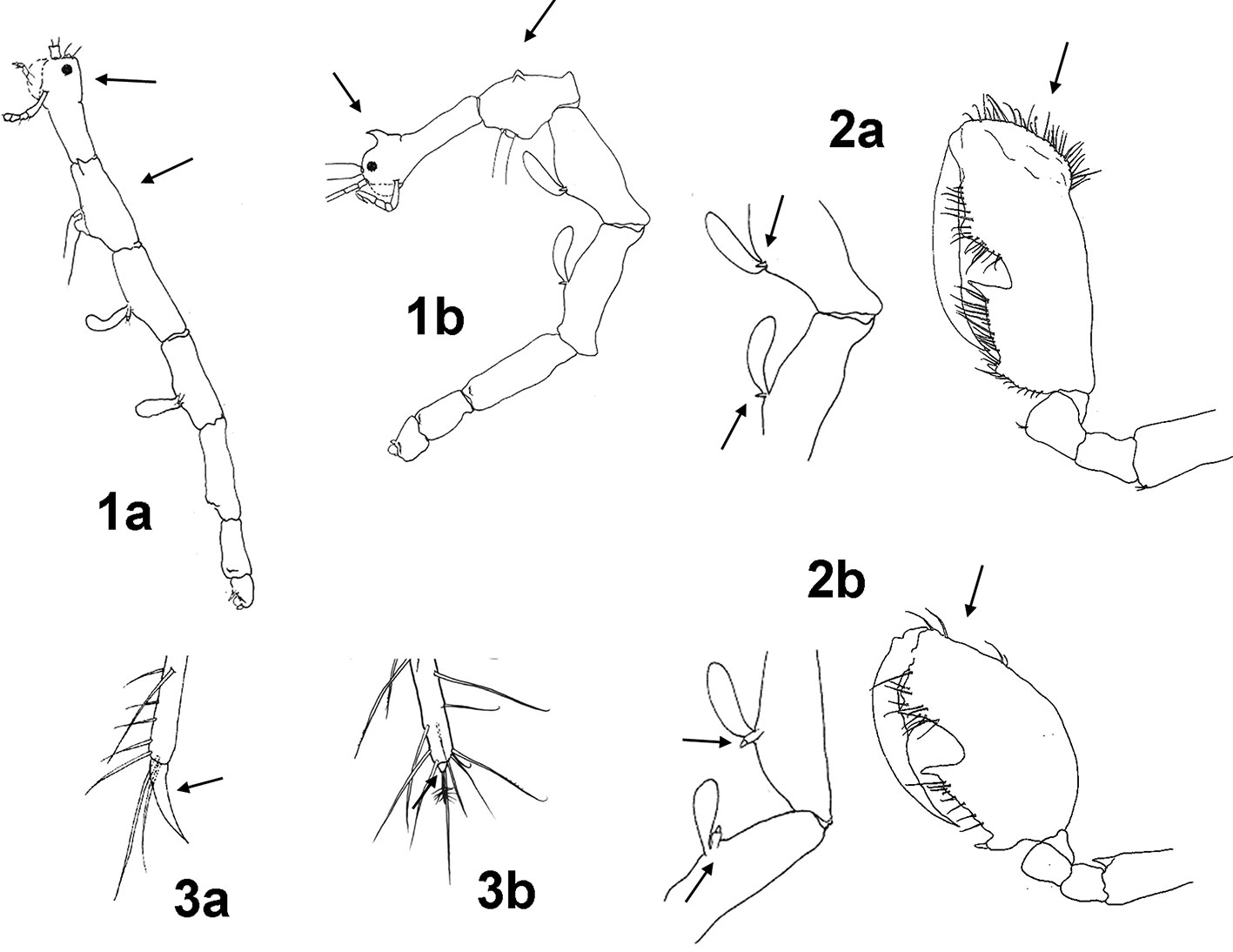
Ilustrated key to Deutella species from the GoM (Fig. 7).
1a. Body dorsally smooth ………..Deutella mayeri
1b. Body with dorsal projections ……………………………..2
2a. Pereopods 3 and 4 about 1/6 as long as gills. Gnathopod 2 propodus
of adult male widened distally, profusely setose …..Deutella californica
2b. Pereopods 3 and 4 about 1/3 as long as gills. Gnathopod 2 propodus
of adult male not widened distally, scarcely setose ……………………………..3
3a. Distal article of pereopod 5 with the typical dactylus shape ………..Deutella incerta
3b. Distal article of pereopod 5 extremely reduced, vestigial Deutella pseudoincerta
Acknowledgements
To Programa de Apoyo para la Superación del Personal Académico, Dirección General de Asuntos del Personal Académico, UNAM (PASPA-DGAPA-UNAM, 2019), for the financial support to travel to the Universidad de Sevilla, Facultad de Biología, for the first author. Also, thanks are due to the Comisión Nacional de Acuacultura y Pesca (Conapesca-DGOPA) for the collecting license. Additionally, we would like to thank to Miguel A. Lozano Aburto (IIMyP-UV-Boca del Río) for his support during the sampling campaign, and Oliver Coleman and an anonymous reviewer for their comments and suggestions.
References
Alarcón-Ortega, L., & Carballo, G. (2019). A new species of Deutella Mayer 1890 (Crustacea: Amphipoda) from the Mexican Pacific coast. Zootaxa, 4612, 581–590. https://doi.org/10.11646/zootaxa.4612.4.10
Chávez, E. A., & Hidalgo, E. (1988). Los arrecifes coralinos del Caribe noroccidental y Golfo de México en el contexto socioeconómico. Anales del Instituto de Ciencias del Mar y Limnología, Universidad Nacional Autónoma de México, 15, 167–175.
Diaz, Y. J., Guerra-García, J. M., & Martín, A. (2005). Caprellids (Crustacea: Amphipoda: Caprellidae) from shallow waters of the Caribbean coast of Venezuela. Organisms, Diversity and Evolution, 5, 249–251. https://www.senckenberg.de/odes/05-10.html
Guedes-Silva, E., & Souza-Filho, J. F. (2013). A new species of Aciconula (Amphipoda: Corophiidea) from Brazilian waters. Journal of the Marine Biological Association of the United Kingdom, 93, 1835–1841. https://doi:10.1017/S0025315413000155
Guerra-García, J. M. (2002a). Two new species of Deutella Mayer, 1890 (Crustacea: Amphipoda: Pariambidae) collected by the R.V. ‘Anton Bruun’ during the International Indian Ocean Expedition 1963–1964. Zootaxa, 74, 1–18. https://doi.org/10.11646/zootaxa.74.1.1
Guerra-García, J. M. (2002b). Littoral caprellids (Crustacea: Amphipoda: Caprellidae) from Philippines, with the description of a new species. Raffles Bulletin of Zoology, 50, 395–406.
Guerra-García, J. M. (2003). Revision of the genus Deutella (Crustacea: Amphipoda: Caprellidea) with description of a new species, redescription of Deutella venenosa Mayer, 1890 and a key to the species of Deutella. Journal of Natural History, 37, 1059–1084. https://doi.org/10.1080/00222930110104267
Guerra-García, J. M. (2004). The Caprellidea (Crustacea, Amphipoda) from Western Australia and Northern Territory, Australia. Hydrobiologia, 522, 1–74. https://doi:10.1023/B:HYDR.0000029929.07691.a7
Guerra-García, J. M., Krapp-Schickel, T., & Müller, H. G. (2006). Caprellids from the Caribbean coast of Colombia, with description of three new species and a key for species identification. Boletin de Investigaciones Marinas y Costeras, 35, 149–194. https://doi.org/10.25268/bimc.invemar.2006.35.0.222
Iwasa-Arai, T., Leite-Siqueira, S. G., De Oliveira-Machado, G. B., & Pereira-Leite, F. P. (2019). Phylogenetic reconstruction of the genus Pseudaeginella (Amphipoda: Caprellidae), with the description of a new species from Brazil, Systematics and Biodiversity, 17, 179–189. https://doi.org/10.1080/14772000.2019.1572668
Lim, J. H., Azman, B. A. R., & Othman, B. R. (2019). A new species of Aciconula (Amphipoda, Senticauda, Caprellidae) from Sultan Iskandar Marine Park, Malaysia. Zookeys, 859, 17–29. https://doi.org/10.3897/zookeys.859.33284
Lowry, J. K., & Myers, A. A. (2013). A Phylogeny and Classification of the Senticaudata subord. nov. (Crustacea: Amphipoda). Zootaxa, 3610, 1–80. https://doi.org/10.11646/zootaxa.3610.1.1
Mayer, P. (1903). Die Caprellidae der Siboga-Expedition. Siboga Expedition, 34, 1–160.
https://doi.org/10.5962/bhl.title.53742
McCain, J. C. (1968). The Caprellidae (Crustacea: Amphipoda) of the Western North Atlantic. Bulletin of the United State of the Natural Museum, 278, 1–147. https://doi.org/10.5962/bhl.part.8960
Paz-Ríos, C., Guerra-García, J. M., & Ardisson, P. L. (2014). Caprellids (Crustacea: Amphipoda) from the Gulf of Mexico, with observations on Deutella mayeri, redescription of Metaprotella hummelincki, a taxonomic key and zoogeographical comments. Journal of Natural History, 48, 2517–2578. https://doi.org/10.1080/00222933.2014.931481
Pearse, A. S. (1908). Descriptions of four new species of amphipodous Crustacea from the Gulf of Mexico. Proceeding of the United State of the Natural Museum, 34, 27–32.
Winfield, I., & Ortiz, M. (2013). The Caprellidea (Crustacea: Peracarida: Amphipoda) from the Gulf of Mexico
with a description of a new species of Paracaprella.
Scientia Marina, 77, 161–168. https://doi:10.3989/scimar.03753.26C

